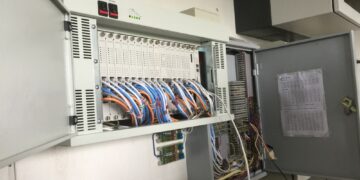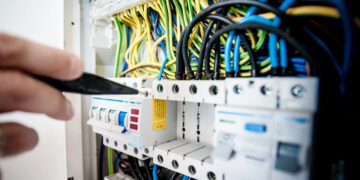Blockchain technology stands today as a pioneering innovation of the twenty-first century because it operates behind cryptocurrencies and decentralized apps and supply chain tracing. Blockchain networks require robust sustainable and scalable crypto power infrastructure because their development shows no signs of slowing down.
Blockchain networks that perform cryptocurrency mining require their underlying power infrastructure to serve as the core base that supports network operation. The stability together with scalability and lasting characteristics of crypto power infrastructure systems must be strong to support the growing transaction frequencies and processing requirements of these blockchain networks along with expanding energy consumption metrics.
What is Crypto Power Infrastructure?
A crypto power infrastructure consists of power systems and distribution units and backup solutions which provide necessary electricity to operate cryptocurrency mining facilities and data centers as well as blockchain networks. The infrastructure delivers power supplies to mining rigs with additional components that include cooling systems and generators and UPS (Uninterruptible Power Supply) systems which maintain operational continuity.
The blockchain verification process called crypto mining needs tremendous computational strength as a fundamental requirement. ASICs and GPUs used by miners solve complicated cryptographic puzzles so that they need large amounts of electricity for their operations. Blockchain network expansion leads to increasing demands on crypto power infrastructure that requires efficient and sustainable and scalable solutions.
1. Ensuring Scalability for Growing Blockchain Networks
Blockchain networks need increased computational power to process transactions when they experience higher transaction volumes. Operation of the crypto power infrastructure needs proper scaling to fulfill expanding requirements.
Scaling a blockchain network involves:
- Increasing hash rates: The hash rate directly correlates to the required computational power which ensures both transaction validation and new block mining. Adding more advanced mining rigs as protection for network security and speed operation requires additional energy.
- More mining hardware: Blockchain network growth demands proportional growth of mining hardware installations. Proof-of-work for Bitcoin demands worldwide miners to perform energy-consuming competitions with state-of-the-art ASIC machines that number in the thousands. The rising power requirements prompt the need for resilient and expansive crypto power facilities to maintain operation.
2. Ensuring Energy Efficiency and Sustainability
Solutions for these issues can be found by implementing robust crypto power infrastructure. The power infrastructure requires energy-efficient operation by adopting renewable energy generation alongside power-efficient technological solutions for sustainability. For example:
- Renewable energy integration: The power needs of mining operations are increasingly being supplied by renewable resources such as hydroelectric, wind energy and solar power as they work to decrease their environmental impact. When clean energy sources fuel crypto power infrastructure to power mining rigs the emissions of blockchain operations decrease substantially.
- Energy-efficient cooling systems: The consumption of energy at data centers demands significant quantities for operating both mining rigs and their cooling systems. Liquid cooling and immersion cooling systems represent vital crypto power infrastructure elements because they maximize energy utilization while preserving hardware operational efficiency.
- Power factor correction (PFC): PFC technology enhances power efficiency because it adjusts electrical power supply factors to maximize usage. Power efficiency improves in mining operations by applying this method which reduces both energy wastage and operational expenses.
3. Redundancy and Reliability for Continuous Operations
Reliability functions as a crucial element within crypto power infrastructure. System uptime needs to be close to total during all operational hours for blockchain networks that conduct financial transactions. Single power outages result in major disruptions which lead to revenue loss together with potential network weak points.
- Uninterruptible Power Supply (UPS): Short power interruptions do not disrupt mining rigs and data centers when equipped with an Uninterrupted Power Supply (UPS). Through backup power supply UPS systems enable mining operations to maintain continuous function during power outages thus avoiding data loss and system damage.
- Generator backup: Back-up generators serve as an essential component to operate crypto power infrastructure during prolonged power outages. Mining operations powered by generators stay in constant operation through all times of day even when power interruptions occur or when electrical grid failures take place.
- Dual power feeds: Mining operations with blockchain data centers must have redundant power feeds which allows them to maintain continuous operation when switching between different power grids. This strategy improves overall system reliability. The additional power sources serve as a backup system to maintain continuous operations regardless of external events.
4. Meeting Geographic and Regional Challenges
The geographic location functions as a key element for designing crypto power infrastructure systems. The ease of access to inexpensive renewable energy sources directs mining establishments to particular geographic regions. Plenty of low-cost energy together with excess renewable power supplies (such as geothermal energy in Iceland) creates favorable conditions for mining operations to grow efficiently.
The crypto power infrastructure located in countries such as China Canada and Norway uses affordable hydroelectricity as well as other renewable power to meet local requirements. Mining operations face challenges when located in regions that cannot afford affordable power because the expensive energy prevents them from performing large-scale mining operations effectively.
5. Future Trends in Crypto Power Infrastructure
As blockchain technology continues to mature, so too will the crypto power infrastructure that supports it. The future of this infrastructure will likely see several advancements:
- Edge computing: Efficient blockchain operations can occur through edge computing methods that distribute processing power nearer to data production sites for faster results. The infrastructure should be redesigned to achieve decentralized operations between multiple locations.
- Blockchain integration with smart grids: Blockchain networks extend their capabilities by integrating with smart grid technology which enables more efficient handling of power distribution and management systems. Coordinated strategies based on this approach will improve the management of energy resources and match Energy requirements between different regions of mining activity.
- AI and machine learning: Real-time power optimization strategies through artificial intelligence and machine learning systems enable crypto power facilities to change their operations based on the performance of their rigs alongside temperature monitoring and energy availability metrics.
Conclusion
Scaling blockchain networks relies heavily on the crypto power infrastructure for maintaining the success of the entire ecosystem. Crypto power infrastructure which supports cryptocurrency mining and blockchain operations requires robustness combined with scalability and dependable and redundant power transmission alongside sustainable solution integration and efficient energy usage capabilities.
The expansion of blockchain networks depends on effective cost-efficient sustainable power infrastructure development which will reduce environmental impact and optimize operations. The infrastructure behind blockchain solutions forms its key foundation because renewable energy combined with energy-efficient technologies and advanced power management enables its sustainable evolution.























































